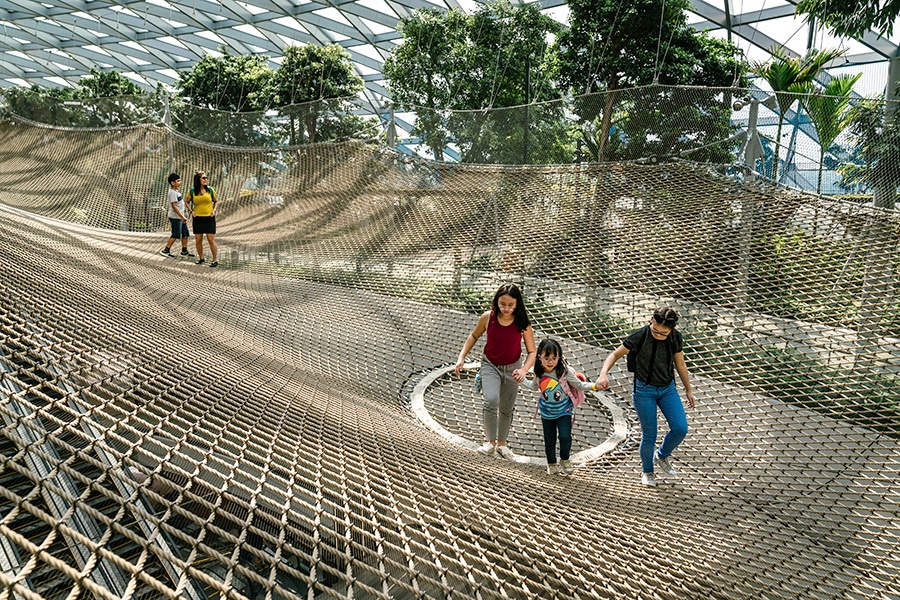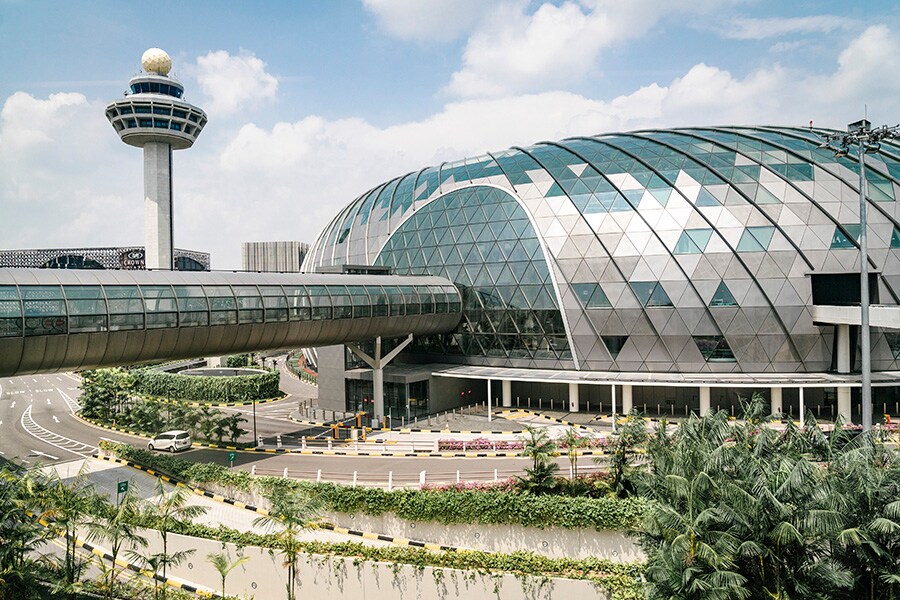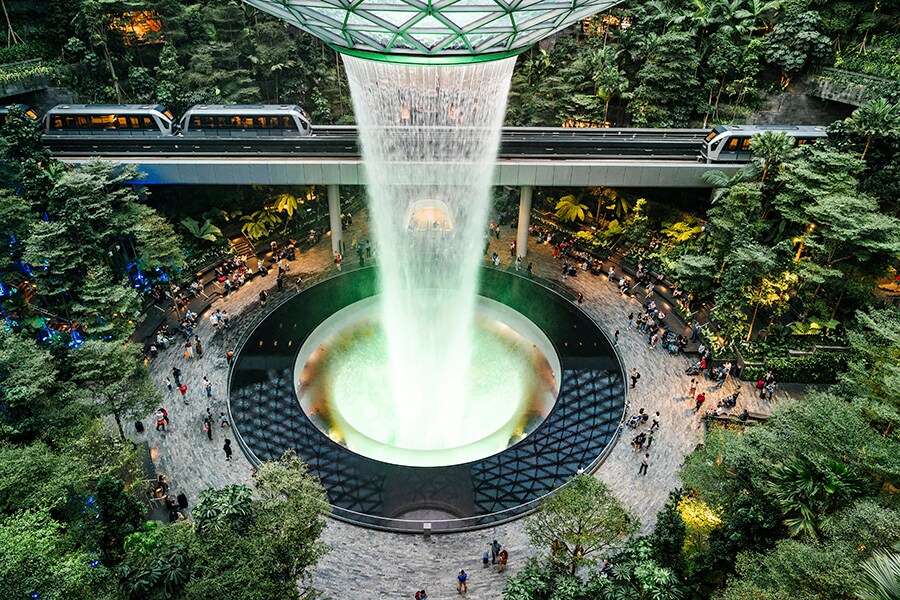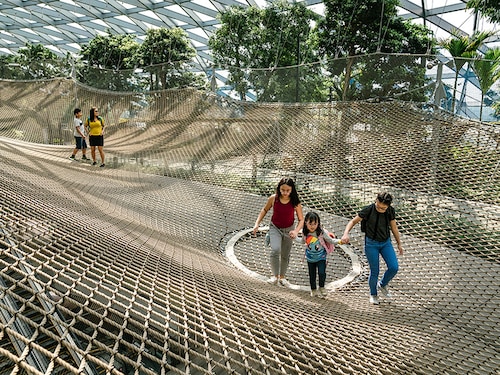 Visitors walk 82 feet above the floor on a "Sky Net" in the Jewel complex at Singapore Changi Airport, Nov. 6, 2019. With a soaring waterfall, forests, endless shops and restaurants, and even a sound-and-light show, a few hours’ layover in Changi Airport may not be enough time. (Lauryn Ishak/The New York Times)[br]Beneath a giant glass dome, where a waterfall plunges 130 feet through a forest, and a winding path leads past palms and fig trees, orchids and anthurium, a robot came rolling around a bend.
Visitors walk 82 feet above the floor on a "Sky Net" in the Jewel complex at Singapore Changi Airport, Nov. 6, 2019. With a soaring waterfall, forests, endless shops and restaurants, and even a sound-and-light show, a few hours’ layover in Changi Airport may not be enough time. (Lauryn Ishak/The New York Times)[br]Beneath a giant glass dome, where a waterfall plunges 130 feet through a forest, and a winding path leads past palms and fig trees, orchids and anthurium, a robot came rolling around a bend.
It was about 5 feet tall, and cruising my way. In its frame were shelves of bottled water and, with a lilting voice, it encouraged passersby to grab a drink. Delighted, I obliged. Alas, the robot didn’t stick around for small talk — and neither did I. It was time to cross a Sky Net suspended more than 80 feet in the air.
So began my airport vacation.
Before you recoil at the thought of an airport holiday, let me explain. This is no ordinary airport. It’s Singapore’s Changi: part theme park, part futuristic pleasure dome. And while an airport is typically a limbo — a swinging door between where you’ve been and where you’re going — Changi is the rare airport that invites you to stay. A view of Singapore Changi Airport from the Skytrain, Nov. 6, 2019. With a soaring waterfall, forests, endless shops and restaurants, and even a sound-and-light show, a few hours’ layover in Changi Airport may not be enough time. (Lauryn Ishak/The New York Times)[br]Indeed, it’s so inviting, that while planning a trip to Southeast Asia, I suggested to my husband that rather than just transit at Changi, we stay overnight. The plan was to spend 27 hours taking advantage of its dazzling attractions. I could idle in the rooftop Sunflower Garden watch butterflies in the tropical sanctuary get lost in the Mirror Maze zoom through a tube slide and explore indoor “walking trails,” as verdant as any found outside. Never mind airplanes. Changi’s website reads like a brochure for an all-inclusive resort: free movies in 24-hour theaters, retro arcade games, light-and-sound shows starring the soaring waterfall spilling from an oculus in a roof.
A view of Singapore Changi Airport from the Skytrain, Nov. 6, 2019. With a soaring waterfall, forests, endless shops and restaurants, and even a sound-and-light show, a few hours’ layover in Changi Airport may not be enough time. (Lauryn Ishak/The New York Times)[br]Indeed, it’s so inviting, that while planning a trip to Southeast Asia, I suggested to my husband that rather than just transit at Changi, we stay overnight. The plan was to spend 27 hours taking advantage of its dazzling attractions. I could idle in the rooftop Sunflower Garden watch butterflies in the tropical sanctuary get lost in the Mirror Maze zoom through a tube slide and explore indoor “walking trails,” as verdant as any found outside. Never mind airplanes. Changi’s website reads like a brochure for an all-inclusive resort: free movies in 24-hour theaters, retro arcade games, light-and-sound shows starring the soaring waterfall spilling from an oculus in a roof.
The back story
Last year, more than 65.6 million passengers passed through Changi. That put it among the top 20 airports in the world for passenger traffic, cargo and aircraft movements in the latest World Airport Traffic Report from Airports Council International, a trade association. Yet as busy as Changi is, for the past seven years air travelers have voted it the world’s best airport, according to Skytrax, the London-based air transport rating organization. This year, Changi upped the ante by opening Jewel Changi Airport, a glass-and-steel shopping and entertainment complex accessible to travelers and locals alike.
While more airports are introducing diversions besides upscale shopping and eating — like the opening this year of an infinity edge pool and observation deck at the TWA Hotel at John F. Kennedy International Airport in New York City — none have pushed the envelope as far as Changi — and Jewel is the latest evidence of that. Yes, there are fashionable restaurants, shops and bars. But there are also eye-popping gardens and whimsies that wouldn’t be out of place in Willy Wonka’s chocolate factory: Animals made of bright flowers a field where children can play amid fog that rises from the ground a glass-bottomed bridge a hedge maze with blooms that snap closed before you can stop and smell that they aren’t real.
So what happens to a traveler when an airport is a high-octane destination unto itself? I checked into the Crowne Plaza Changi Airport (named the world’s best airport hotel for the fifth consecutive year, according to Skytrax) to find out.
Sunrise check-in
It was 7 a.m. when I arrived at the Crowne Plaza, which I chose because, despite being in a terminal, the hotel feels a bit like a tropical resort. (This was, after all, a vacation.) There’s an outdoor pool and lounge chairs, wood decking, islands with palms. You can practically swim up to some rooms. Open-air hallways flanked by reflecting pools let in the Singapore heat and lend a sultry atmosphere. And the hotel’s location next to a bridge to Jewel means you can walk right into Changi’s latest draw (though it’s worth a Skytrain ride sometime for a close-up of the waterfall). Since my flight was arriving in the morning, I’d arranged to pay an additional fee (160 Singapore dollars, or about $118) to check-in early, so there was no wait for the room. (Those who wish to stay right inside Jewel may want to give the nascent Yotelair a try.)
A morning stroll around Jewel
After unpacking I headed over to Jewel, which its architect, Moshe Safdie, described in Architectural Digest as a kind of “mystical paradise garden.” Standing on a viewing deck amid its tall trees and thousands of lush shrubs — the waterfall pouring right through the building — you can’t help but be enchanted. I marveled at its inventiveness, scale and beauty. Visitors wearing backpacks and wheeling luggage stopped to pose for photos, the falls hissing behind them like a newfangled Niagara. When sunlight hit the water just so, there was even a rainbow.
As with all wonderlands, though, there’s a fine line between fantasy and dystopia. Looking around, it isn’t hard to imagine a future in which everyone lives in domed cities in temperature-controlled, never-ending summers. Signs refer to “trails” that you can “hike,” as if Jewel’s smooth, clean floors are rugged arteries through the wilderness. The trees and shrubs around the waterfall have a corporate name: the Shiseido Forest Valley, after the Japanese beauty company. The waterfall is officially known as the HSBC Rain Vortex. And it’s surrounded by stores and restaurants, allowing a visitor to keep one eye on the jungle-scape and the other on the latest fashions at Calvin Klein — or the queue for Shake Shack. The result is a staggering display of artificiality and nature, with lights that can turn a waterfall crimson, or make it seem as if you’re dining al fresco under a starry sky.
Beneath that sky, on Jewel’s tree-lined top floor, is Canopy Park, where we went to try theme-park style attractions (standard tickets for adults start at SG$5): mazes, slides and the Manulife Sky Nets, one for bouncing, the other — the one I would soon choose to follow — for walking.
Late-morning balancing act
“Just don’t look down,” my husband said.
Reader, I did. Far beneath my sneakered feet were the tops of people’s heads and I instantly imagined falling through the net into the display of acrylic boxes at the Muji store below. I gripped my husband’s arm while a woman who looked to be about 70 bounced past us, hands in the air, grinning and waving at a little girl not far behind.
Eventually, I made it back to terra firma where I realized that land-based activities, like the Mirror Maze (for which I’d been given a foam noodle to tap the space in front of me as a way to avoid bumping into a mirror) were more my speed. Indeed, while Cirque du Soleil-style recreation is novel and fun (ahem, for some), Changi is at its best when it conjures something of the spirit of its home, of Singapore, the polished “city in a garden.”
Lunchtime restaurant-hopping
With award-winning restaurants and specialties from Singapore and throughout Asia (Singaporean cuisine from Violet Oon Singapore hotpot from Beauty in The Pot), we treated lunch at Jewel like a cruise ship smorgasbord. A friend who lives in Singapore joined us for dim sum (prawn dumplings, shredded chicken spring rolls, barbecue pork buns) at Tim Ho Wan, an outpost of the Hong Kong-based Michelin-star winner (even so, it’s surprisingly affordable). Afterward, it was on to Japanese Soba Noodles Tsuta, a branch of the first ramen restaurant to receive a Michelin star, where we had the Shoyu soba followed by raw milk, soft-serve ice cream from Japan’s Icenoie Hokkaido and “botanical gelato” in flavors like white chrysanthemum (imagine the taste of flower florets and cacao nibs) from Birds of Paradise.
All afternoon we browsed regional snack and confection stalls as if we were at a street market. At Rich & Good Cake Shop, known for its Swiss rolls, a sign said that “due to overwhelming demand and limited stock,” each adult was allowed only one item. Of the small boxes, the sole remaining flavor was durian, a fruit so pungent it’s not allowed on public transportation in Singapore. Meanwhile, over at Irvins Salted Egg, maker of salted egg-flavored treats, almost everything was sold out, though I managed to procure a bag of salted egg potato chips (SG$8) that I later discovered regrettably lived up to the brand’s “dangerously addictive” tagline. The HSBC Rain Vortex, plunging 130 feet, at Singapore Changi Airport, Nov. 6, 2019. With a soaring waterfall, forests, endless shops and restaurants, and even a sound-and-light show, a few hours’ layover in Changi Airport may not be enough time. (Lauryn Ishak/The New York Times)[br]The evening show
The HSBC Rain Vortex, plunging 130 feet, at Singapore Changi Airport, Nov. 6, 2019. With a soaring waterfall, forests, endless shops and restaurants, and even a sound-and-light show, a few hours’ layover in Changi Airport may not be enough time. (Lauryn Ishak/The New York Times)[br]The evening show
Evening came quickly, and with a puff of mist from above, the first of the free nightly light and sound shows at the Rain Vortex began. We joined the scores of visitors slipping out of stores and leaning over balconies, smartphones at the ready, to watch the waterfall try on a kaleidoscope of colors and projections set to rousing music. Perhaps more impressive than the show is the fact that an enormous waterfall can be controlled as if it were a kitchen appliance. Something about this might niggle at the back of the mind as the hours go by. Your animal instincts — initially numbed by Jewel’s astonishing landscape — prick up, and you begin to feel restless, for you know that while there are plants and trees, there’s nonetheless a ceiling between you and the sky.
Dinner, drinks and late-night shopping
After the show, under cafe string lights on Jewel’s top floor, we had dinner at Tiger Street Lab. I enjoyed flatbread with shrimp, guacamole and mango salsa, as well as a half-pint of Singapore’s Tiger Beer, while intoxicated by the sweet scent of the boneless coffee pork ribs (deep-fried and coated with caramelized coffee sauce) by Keng Eng Kee Seafood. Locals, too, come to the airport to eat, socialize and, as another friend living in Singapore pointed out, study, thanks to free air conditioning and Wi-Fi.
We followed dinner with a passeggiata past the glow of gift shops like Naiise Iconic (the Singapore-based store where you can buy books about the city, home décor, and knickknacks like luggage tags) and Supermama (another Singapore-based design shop with crafts such as porcelain plates) Japanese retailers, including Tokyu Hands, where I snapped up designed-in-Japan stationery and global behemoths like Apple, which offers a “photo-walk” in Jewel for those who want photo-taking and editing tips for capturing the surrounding architecture, gardens and Rain Vortex.
An encore before bedtime
As night settled in, we found ourselves under wire-mesh clouds twinkling with Swarovski crystals for the evening’s second sound and light show. Too beat to cap it off with a movie, we strolled back to the hotel and slept soundly in the shadow of the Changi Control Tower.
I barely heard the planes gliding by overhead.
First Published: Dec 04, 2019, 15:41
Subscribe Now